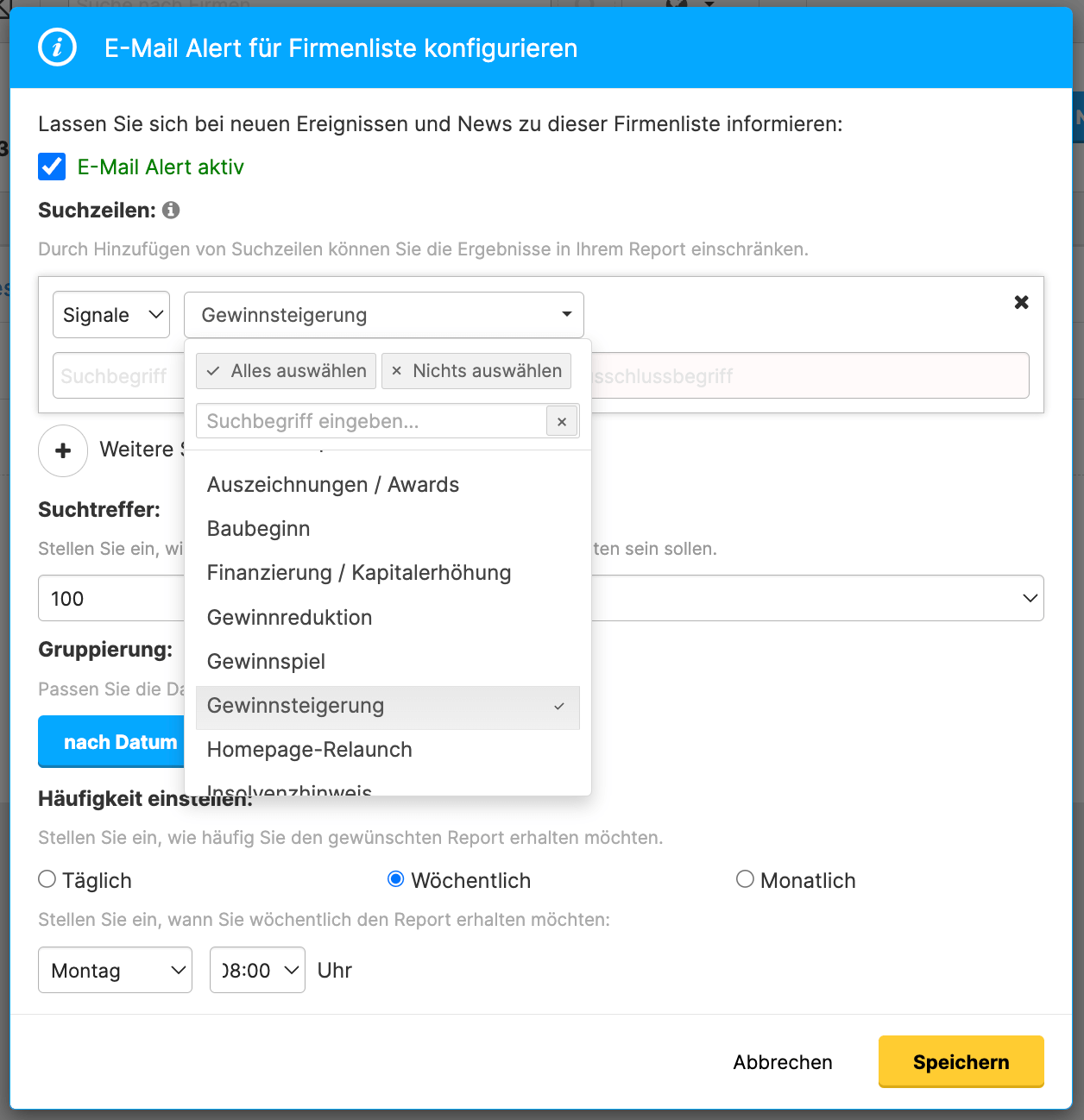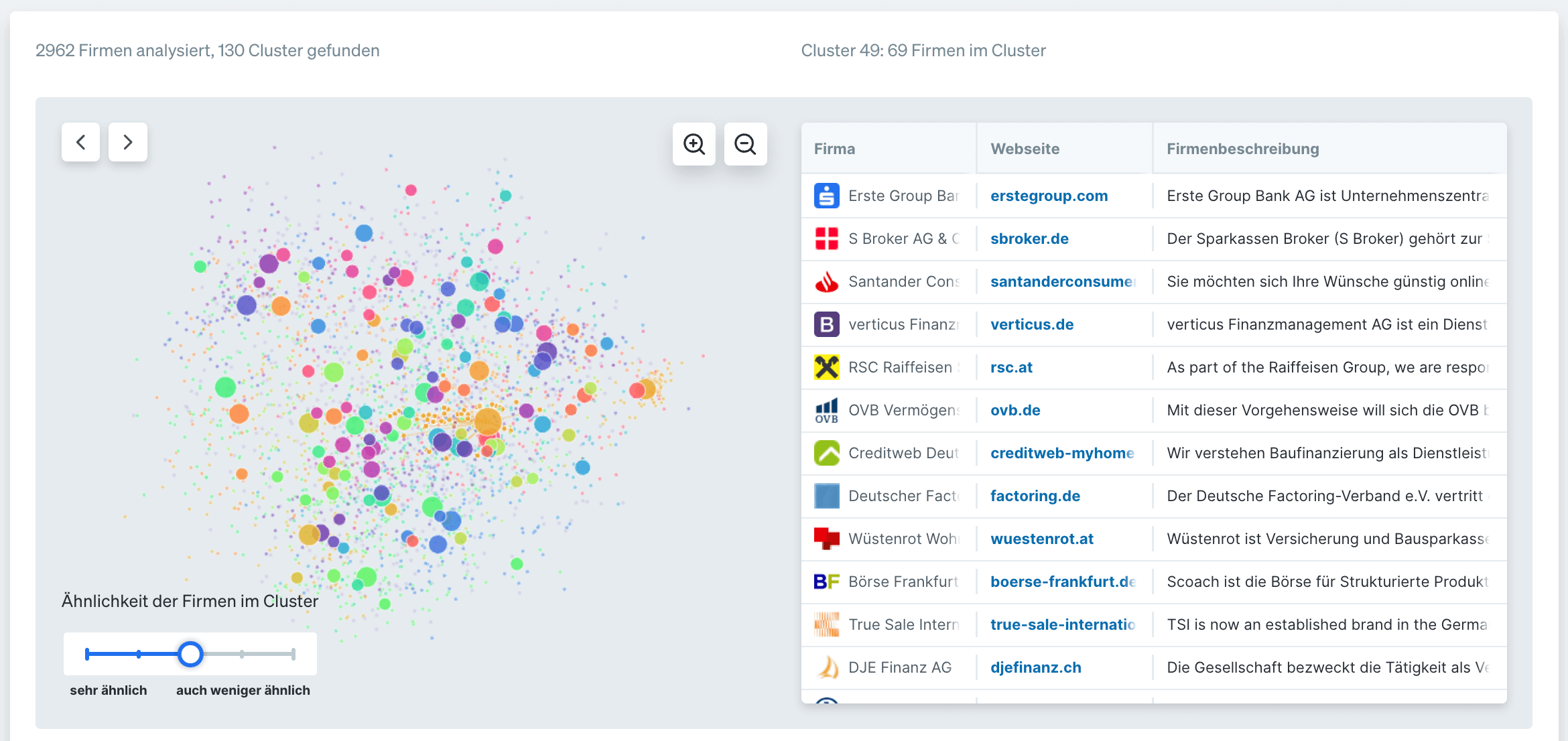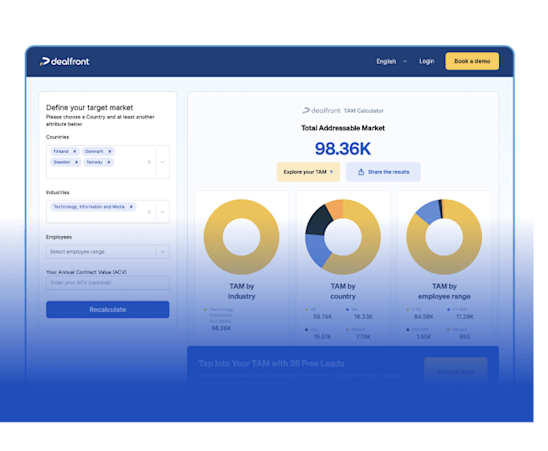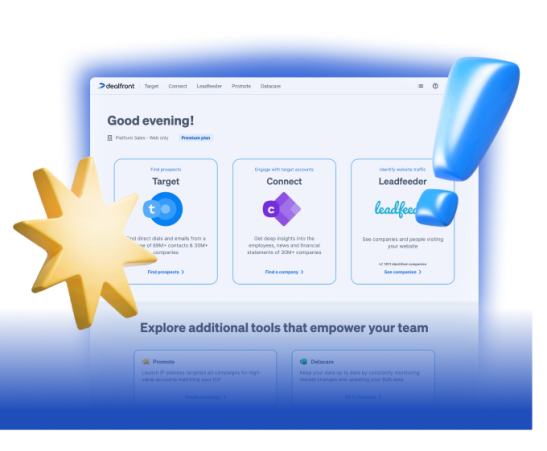Data is everywhere, which is both a blessing and a curse. At times, as marketers, we have so much of it coming from every direction it can be overwhelming. Having the data is amazing, but having usable data you can work with is the tricky part.
At Dealfront we have data, a lot of data, 180m+ contacts and 40m+ companies worth of data to be precise. We package this data in a usable ‘sales intelligence’ solution, but who’s to say it’s just for sales teams? We think there’s so much that marketing teams can do with this data too.
Read on for our advice and suggestions about how marketing can use sales intelligence data to best effect.
What is Sales Intelligence?
Sales intelligence is everything sales professionals need to know about their leads, it’s all the information used in the sales process, and so much more than just some emails or phone numbers. The goal of using sales intelligence is to get a deeper understanding of prospects and leads and use this knowledge to close more deals.
At Dealfront we provide sales intelligence tools filled with sales intelligence data. We only handle B2B data, and even better, we only handle GDPR compliant data. Our information comes from many different sources and is used to inform marketing and sales decisions.
How do Sales Teams Use Sales Intelligence Data?
Sales teams are increasingly tasked to ‘do more with less’. Sales intelligence software helps increase the efficiency and effectiveness of each team member. They can spend more of their time on outreach and engagement, and less on research and qualification.
In a well-built tool, often all it takes is a few clicks to build a list of companies that match your ideal customer profile. In an even better-built tool, the contact details of key decision makers will be connected to these companies and at your fingertips too. What previously took hours away from actual sales conversations taking place, can now be done in minutes. Watch this video to learn more about it.
Company insights within sales intelligence tools also support the efficiency of the sales process. At Dealfront we call these insights Triggers, these are intent triggers and cover a huge range of topics, including financial losses, construction plans, increase/decrease in revenue, homepage relaunch, job openings and many more. These triggers help to identify companies with a higher propensity to buy, or rule out those where time would be better spent elsewhere.
Sales Intelligence Data for Marketers
In many companies, marketing teams are targeted on the volume of leads, and the sales team targeted on conversions. This creates a mismatch between the two departments and invariably some friction.
When marketing has access to sales intelligence data this can help smooth the cracks and bring the departments closer together. Marketing teams (or individuals if you’re a solo star!), can build more refined lists, making it more specific who receives what messaging, resulting in more effective campaigns.
The win-win is that marketing can still achieve their volume targets, but by building an audience of a higher quality, the sales team has a stronger chance of conversion.
How can Marketing Teams Use Sales Intelligence Data?
Now we’ve explained the premise, let’s get into how marketers can make the most out of sales intelligence data! Along the way we’ll share how you can do this with the tools in the Dealfront Sales Intelligence solution: Target, Connect and Datacare.
Target: Target is a B2B sales prospecting tool with unique filters that helps you create company and contact lists, as well as find the contact details of key decision-makers.
Connect: Connect provides in-depth B2B contact database; from trade registries, company websites, news, and social media.
Datacare: Datacare helps you review, cleanse, enrich, and optimize your imported data records.
1. Further develop your Ideal Customer Profile (ICP)
When you defined your ICP did you compare the outcome to the prospect data available? Having a clear understanding of which companies you want to target is essential, but this information becomes irrelevant if it’s unusable.
To define your ICP you probably performed some kind of exercise like looking at who your best current customers are, analyzing these and grouping common characteristics and challenges. In an ideal world this research would have been done through multiple techniques such as customer interviews, joining sales calls, monitoring reviews and social media responses.
So how do we know if our chosen ICP is helping or hindering us? A good test is to put the attributes of your ICP into a sales intelligence data tool and see what comes out the other side. For ICP you’re only looking at company data, so things like industry, location, employee count, years in business, funding type, etc.
To do this in Dealfront, combine the many filters in Target to achieve a refined search. If this is a search you want to come back to in the future, save it to refer to again later.

Search results in Target
Once you see how many companies could be viable in the search results, you next need to see what kind of contact data fits.
You’ll no doubt also have buyer personas. From this research can you pull out what kind of contacts you’d want to reach? In Target you can further filter by criteria like job title, seniority or number of employees per department.
Lastly, you obviously don’t want any existing customers in your prospect list, so you’d need to filter out these too. From your CRM, or however you store your customer data, export a list of current companies you work with. Import this list through Dealfront’s Datacare, map the columns, review any queries and save. You can then filter by this saved list within Target.
What are you left with? Is it a list that you’ll exhaust fairly quickly, or is it a healthy quantity to work from for a while. If it’s too refined, unless you’re in an incredibly niche industry, you may want to loosen up the criteria a little to give yourself more opportunities to succeed.
Once the quantity is just right you can start using the intent data found in sales intelligence tools to look for opportunities to market to certain segments. Maybe you want to run a campaign to those in your ICP who are hiring, or who recently won an award - it’s over to you!
2. Calculate your Total Addressable Market (TAM)
How do you calculate realistic marketing targets for your business? Do you pluck a figure out of thin air? Or do you have a formal process to work out where you sit in the market and how much opportunity is out there?
Working out your Total Addressable Market (TAM) can show you how much market demand there is for your product or service. Your TAM is the maximum amount of revenue your company can possibly generate by selling to a specific market. The simplest way to work out your TAM is to multiply your annual contract value (the average sales price x number of current customers) by your total number of potential customers.
This is where Sales Intelligence data comes in, it can help you find the number of potential customers in your market. To do this in Dealfront, you’d run a search in Target, applying filters to narrow down the results to your ideal market. You might only include certain industries, locations, website keywords, company sizes, or any criteria that fits who you can realistically sell your products and services to.

A search in Target
Once you’ve run your search you’ll see the total number of companies found, you then just need to multiply this by your average contract value and you’ll have an idea of your TAM.
Knowing what the landscape looks like can help inform your marketing strategy (and set realistic expectations higher up the chain). Do you have a huge market to apply more mass marketing tactics to, or do you need to get more niche, perhaps with account-based marketing (ABM)?
3. Build and refine your display ad audiences
Display advertising uses a typical ‘push’ approach. Ads are displayed to users who didn't directly search for the product or service, but they have been targeted for a reason.
These ads are displayed through a publisher's display network and targeted based on chosen criteria. The Google Display Network and LinkedIn Audience Network are examples of well-known publishers.
There’s increased pressure on media teams to reduce wastage and become more granular in their approach. Remarketing to companies who have previously visited your website is one way, but programmatic company targeting is another. This is where sales intelligence data comes in.
To target a list of companies with display ads, you first need to build and refine that list. Using the many filters in Dealfront’s Target you can search for your ICP, or the profile of the companies you wish to outreach to via display advertising.
You can get as detailed as you like with building your list, using standard firmographic filters, or combining these with trigger events to identify and advertise to companies displaying certain behaviors or intent. For example, your offering might be perfectly suited to companies with construction plans, reaching them right at the start of their buying journey.
By saving this search as a list you can then target these companies with display ads in just a few clicks using Promote, Dealfront’s B2B advertising tool, without needing to leave the platform. You can also advertise with Promote by uploading a list you’ve collated elsewhere.

Selecting a list in Dealfront’s Promote
Dealfront’s sales intelligence data can be used outside of the platform too. Once you’ve built your list you can export it, choosing the format to suit your needs best, including a LinkedIn formatted CSV, for uploading to the LinkedIn advertising platform.
Company targeting on LinkedIn enables you to run account-based marketing campaigns, target by professional demographics and drive more conversion. You can use this focused approach to reach the decision makers at your highest value accounts, guiding them along your journey and ultimately towards becoming qualified leads.

Exporting a list in Target
Using sales intelligence data you can successfully fill up the top of your funnel and start prospects on their journey with your company.
4. Choose the right prospects every time
When it comes to outreaching to prospects (GDPR and country regulations aside), marketing often has quite a wide net. Lists are often segmented in some way, so there is personalisation and specific targeting, but resources can quickly get spread thinly and result in an excess of unqualified leads passing to sales.
In the interests of working in harmony with sales to fill the funnel with valuable leads, sales intelligence tools can help! Narrowing down your prospect list/s to those who are the most likely to convert is a more strategic approach and aligns the goals of both departments.
There are a couple of different ways to do this with Dealfront:
If you’re starting from scratch you can use our many company and contact filters, plus intent triggers, to build out your marketing prospect lists. Lists can be saved within Dealfront as part of your contract and exported to a CSV/XLS/LinkedIn/Salesforce format using credits.
If you have an existing prospect list you can both enrich and refine this through our Datacare tool. Any outdated information will then be updated, leading to lower bounce rates and fewer awkward phone calls, no more, “Mr XYZ left the company 3 years ago”. You can then filter against all our data using this list and any other filters you wish, to refine further if required. Then save or export as mentioned above.

Saved Lists in Dealfront
You’ll now not only have more accurate data, but have gained a stronger alignment with sales.
5. Enrich your lead data
When you capture lead data, either online or live in person, you typically only ask for the essentials. As marketers, we’re taught from day one to not ask for too much information during data capture or we’ll scare prospects away. Sales intelligence software can enrich this basic data, turning it into detailed, valuable information you can use to better qualify, profile and ultimately route your prospects over to sales.
Datacare is Dealfront’s cloud-based data matching and cleansing software. In simple terms, you take a list of companies and import it into Datacare, machine learning then match the input data and our database records. All you need for a successful company import in Datacare is the company website and company name.

Dealfront’s Datacare
A few clicks later to review and confirm the matches and your previously sparse list now contains a wealth of enhanced company data, ready to use. Once you’ve enriched your prospect data you can then use this to route these prospects to the appropriate sales professionals or teams, whether this is by location, number of employees, revenue, or otherwise. You can also use this data to inform your own marketing campaigns, applying whatever segmentation works for your specific use case.
In no time at all, your previously sparse captured data can be brought to life and given purpose and meaning. You need never worry about removing those ‘nice to have’ input fields from a form again!
6. Find lookalikes with AI tools
Lookalikes are similar companies. In many businesses there will be some key customers where the dream would be to replicate them over and over again - they’re brilliant! With AI, while we can’t promise your dreams will all come true, there are ways of finding similar companies.
When looking for similar companies using the Dealfront AI Tools you first need a starter list. There are a few different ways you could come up with this list.
The obvious place to start is with your current perfect customers, as illustrated above. To do this, import your chosen customer list into Dealfront using Datacare, then search for similar companies in AI Tools.
We’ll now introduce Connect Alerts: these help you to keep an eye on positive and negative business-related changes at the companies on your list. These changes may include relocation, expansion, job offers, and management restructures. You can use these alerts for general market research, or even for ABM campaigns and beyond.

Connect Alerts in Dealfront
Alternatively, you could perform the same actions, but on a list of the most engaged companies on your existing email marketing campaigns, or social media activity, or for companies that interacted with you at an event.

Dealfront’s AI Tools
Once you’ve used the AI Tools to search for lookalikes, you can continue to use the other Dealfront tools on this list, for example to filter by job title/department to find the most suitable new contacts.
In no time at all you’ll have a fresh list of prospects who are exactly the right kind of people to outreach to.
Remember that with any contacts it's your responsibility to adhere to any privacy laws related to outreaching to these. Dealfront legally sources company and contact details, however we aren't responsible for how you choose to use this data.
Align with Sales and Celebrate Your Success Together
In this article we’ve highlighted how sales intelligence data is useful for more than just sales teams. Aligning marketing with sales of course goes beyond using the same data, it also involves having shared goals and regular, effective communication. The combined approach means that both departments take more responsibility for delivering successful campaigns, and both want to see each other achieve their targets.
When it comes to Dealfront, just speak to your Account Manager about adding new seats for your marketing team and you’re good to go!
If you’re not using our Sales Intelligence solution, you can book a no-obligation demo with our sales team, they’ll happily walk you through how it all works. Discover more about our Sales Intelligence solution in our Help Center Quick Start Guide.
Start using sales intelligence data today to boost the achievements of your marketing team and ultimately drive business growth.






